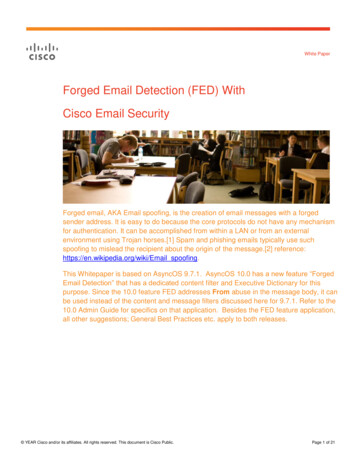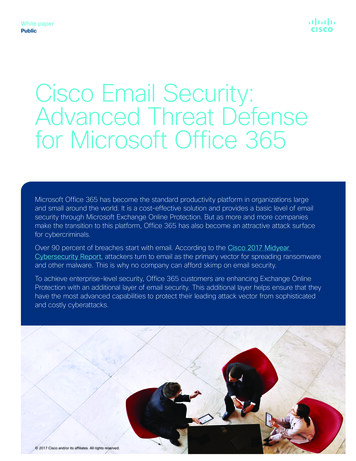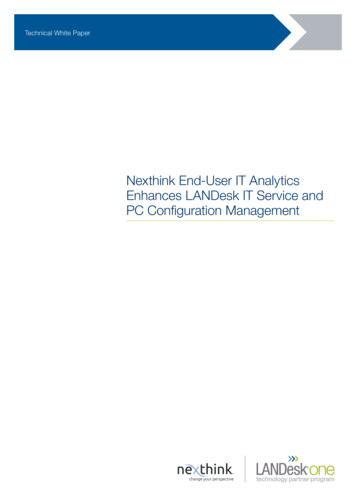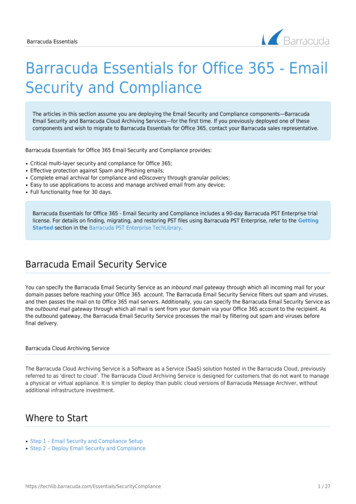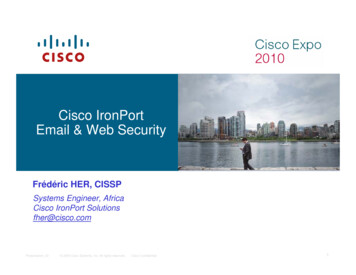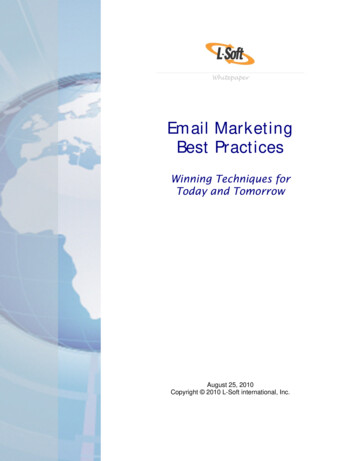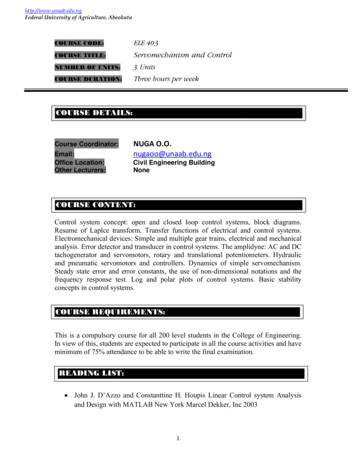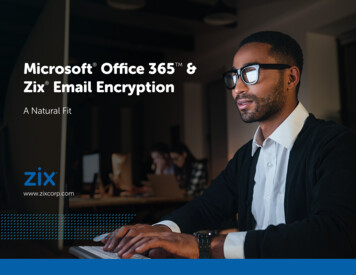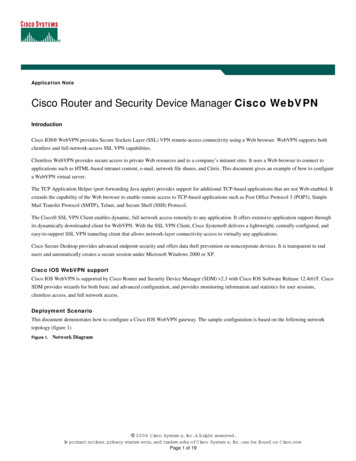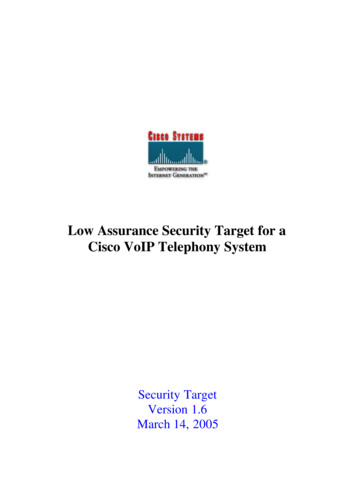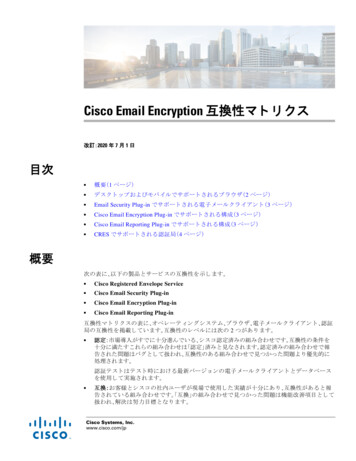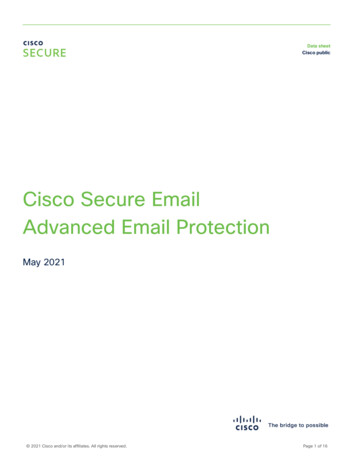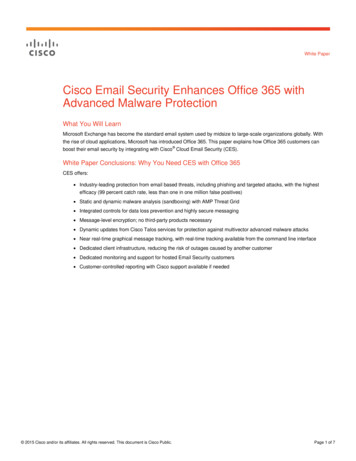
Transcription
White PaperCisco Email Security Enhances Office 365 withAdvanced Malware ProtectionWhat You Will LearnMicrosoft Exchange has become the standard email system used by midsize to large-scale organizations globally. Withthe rise of cloud applications, Microsoft has introduced Office 365. This paper explains how Office 365 customers canboost their email security by integrating with Cisco Cloud Email Security (CES).White Paper Conclusions: Why You Need CES with Office 365CES offers: Industry-leading protection from email based threats, including phishing and targeted attacks, with the highestefficacy (99 percent catch rate, less than one in one million false positives) Static and dynamic malware analysis (sandboxing) with AMP Threat Grid Integrated controls for data loss prevention and highly secure messaging Message-level encryption; no third-party products necessary Dynamic updates from Cisco Talos services for protection against multivector advanced malware attacks Near real-time graphical message tracking, with real-time tracking available from the command line interface Dedicated client infrastructure, reducing the risk of outages caused by another customer Dedicated monitoring and support for hosted Email Security customers Customer-controlled reporting with Cisco support available if needed 2015 Cisco and/or its affiliates. All rights reserved. This document is Cisco Public.Page 1 of 7
Figure 1.Note:Cloud Email Security with Office 365The Cisco Cloud Email Security components include the Content Security Management Appliance, EmailSecurity Appliance clusters, data loss prevention, antivirus and antispam tools, and encryption.The Current EnvironmentWe’ve all been witness to the cloud evolution. Organizations are increasingly moving their operations and resources offsite to provide services that were traditionally housed internally. The migration to online services has provided manybenefits to companies. Even small businesses can now have enterprise-class redundancy and disaster recovery withoutthe capital outlay for telecommunication, network, and server resources.Companies looking to gain competitive advantages are realizing that email, once thought not to be mission critical likefinancial concerns, has become business critical. Companies conduct a large portion of their business by email. Banking,trading, sales contracts, and legal documents, whether secure or not, are all transferred by electronic mail. Companieshave realized that a logical step in moving to the cloud is moving mailboxes to the cloud.Despite the many operational advantages offered by cloud email, these systems are just as likely to be compromised bysophisticated attacks as email hosted on-premises. These threats include zero-day malware, including new, widespreadmalware distribution and targeted, low volume attacks. Snowshoe spam, which involves sending low volumes of spam 2015 Cisco and/or its affiliates. All rights reserved. This document is Cisco Public.Page 2 of 7
from a large set of IP addresses to avoid detection, is an emerging threat. All of these methods have been found to bevery effective and often successful at passing through less-powerful spam filters.The result: Even in the cloud, organizations are bombarded by incessant email attacks from highly sophisticated malwarethreats with the goal to steal your data and those of your customers.Microsoft Exchange Online Protection (EOP)Microsoft EOP is a hosted filtering service that provides protection for Office 365. EOP provides the following features: Antispam filters Antivirus protection Policy enforcement Disaster recovery Directory servicesMore information is available at 30%28v exchg.150%29.aspx.These SLAs and Microsoft Exchange’s market position would seem to point customers toward using Office 365 with EOPas their email security solution. However, customer demand for a more in-depth security solution has led Microsoft toprovide mechanisms for Office 365 to operate with third-party systems. These include RSA Data Loss Prevention andindustry-leading solutions such as the Cisco Email Security cloud and on-premises solutions.Cisco Cloud Email SecurityCloud Email Security is based on the same industry-leading technology that protects 40 percent of Fortune 1000companies from inbound and outbound email threats. Customers can reduce their onsite data center footprint and outtask the management of their email security to trusted security experts. Cloud Email Security provides dedicatedinfrastructure in multiple resilient Cisco data centers to provide the highest levels of service availability and dataprotection. Customers retain access to (and visibility of) the hosted infrastructure. Comprehensive reporting and messagetracking supports exceptional administrative flexibility. This unique service is all-inclusive, with software, hardware, andsupport bundled for simplicity.The service offers these best-in-class features: Talos/SenderBase: Scans traffic around the globe to help protect you from both known and emerging threats,dynamically updating Cisco Email Security solutions every 3-5 minutes. Antispam: To stop spam from reaching your inbox, a multilayered defense combines an outer layer of filteringbased on the reputation of the sender. It also executes an inner layer of filtering that performs a deep analysis ofthe message. Reputation filtering blocks more than 80 percent of spam before it even hits your network. All thisculminates to an industry leading spam catch rate of greater of 99.999 % and a false-positive rate of less than 1in 1,000,000. Graymail detection: Graymail consists of marketing, social networking, and bulk messages. The graymaildetection feature precisely classifies and monitors these types of emails entering your organization. Anadministrator can then take appropriate action on each category of graymail. Graymail safe-unsubscribe: This feature tags graymail with a safe “unsubscribe” option. This option uses thecloud to safely process an unsubscribe request on behalf of the end user. It will also monitor the differentgraymail-unsubscribe requests. All of this can be managed at a policy, LDAP-group level. Anti-virus: We offer the choice and flexibility to deploy either Sophos or McAfee Anti-Virus engines. Theseengines can also run both in tandem, providing a layered approach for additional anti-virus protection. 2015 Cisco and/or its affiliates. All rights reserved. This document is Cisco Public.Page 3 of 7
Outbreak filters: Outbreak filters defend against emerging threats and blended attacks. They can issue rules onany combination of six parameters, including file type, file name, file size and URLs in a message. As Talos learnsmore about an outbreak, it can modify rules and release messages from quarantine accordingly. Outbreak filterscan also rewrite URLs linked in suspicious messages. When clicked, the new URLs redirect the recipient throughthe Cisco Web Security proxy. The website content is then actively scanned, and outbreak filters will display ablock screen to the user if the site contains malware. Web interaction tracking: This fully integrated solution allows IT administrators to track the end users who clickon URLs rewritten by Cisco Email Security. Allowing tracking of messages with malicious links, including whoclicked on the link and the results of their actions. DLP: We partner with RSA, a leader in DLP technology, to provide an integrated, all-in-one DLP solution. Thissolution helps ensure compliance with industry and government regulations worldwide, and helps preventconfidential data from leaving your network. This integrated solution enables DLP policy implementation in as littleas 60 seconds. Email encryption: Cisco’s encrypted email provides the ability to keep your email confidential — only the senderand the recipient can read the email. Including Secure/Multipurpose Internet Mail Extension (S/MIME) TransportLayer Security (TLS) encryption support. AMP add-on: This feature delivers improved inbound threat-detection and monitoring. It provides retrospectivesecurity, which identifies areas of the network affected by a breach and helps quickly return operations to normal. The AMP license includes the following three features:– File reputation: Examines every aspect of a file to determine its security risk.– File analysis (sandboxing): Analyzes files in a secure space to determine malicious intent before they enterthe network.– Retrospective security: Continuously monitors files seen and any disposition changes trigger dynamicreputation analysis and alert the administrator. Detailed information on malware enables remediationprioritization.Additional benefits include role-based administration, 99.999 percent uptime, co-management, multiple U.S. andEuropean data centers for redundancy, Dedicated IP addresses to avoid shared-fate blacklisting, and financially backedSLAs.Cisco is proud to be recognized as a leader in the Gartner Magic Quadrant for Email Gateways 2015.The Cisco Talos Security Intelligence and Research Group (Talos)Email Security is part of Cisco’s comprehensive family of network security products and services. Organizations are betterpositioned to detect and respond to threats when using industry-leading products and services that fall under onevendor’s umbrella.Email Security uses Talos, which sees 35 percent of the world’s enterprise email traffic, 75 TB of web data per day, 13billion web requests, 1.6 million deployed devices, and more than 150 million endpoints. Cisco products integratetechnology from solutions like Cisco Web Security and Cisco Advanced Malware Protection (AMP) Threat Grid, whichaddress unwanted and potentially malicious URLs and file attachments in email. Organizations need this multivectorintelligence to have best-in-class security and protect themselves from the latest of blended threats. 2015 Cisco and/or its affiliates. All rights reserved. This document is Cisco Public.Page 4 of 7
Integrating Office 365 with Cisco Cloud Email SecurityFortunately for Office 365 customers, Microsoft has made integration with third-party systems fairly easy. The ability tocreate smart-host connectors for EOP to route email to these systems is well documented. See the Microsoft Exchangelibrary.Routing Inbound Mail for Spam Filtering to Cloud Email SecurityEmail routing takes place through the use of mail exchange (MX) records. These records are DNS entries that tellsystems where to deliver email. The MX records point to the IP address (usually an inbound NAT translated address onthe firewall), which accepts incoming (SMTP) connections. The MX record typically points to an MTA (message transferagent), which could be a secure email gateway such as the ESA, Microsoft Exchange, Lotus Notes, or an Open Sourcesolution such as Sendmail.As seen in Figure 2, customers may have many MX records pointing to various IP addresses for redundancy. Cisco CloudEmail Security provides customers with two MX records to provide MX redundancy in addition to data center redundancy.Figure 2.MX Records of IP Addresses 2015 Cisco and/or its affiliates. All rights reserved. This document is Cisco Public.Page 5 of 7
The Story of Acme Inc.Let examine how the customer Acme Inc. (a fictitious company) would migrate its email security to Microsoft Office 365and Cisco Cloud Email Security.Today Acme houses its email systems internally, and all messages are filtered by a homegrown application that hasn’tprovided the level of protection necessary for Acme’s employees. Acme wants to move the employee mailboxes as wellas the email security infrastructure to the cloud. To do this, it has selected Microsoft Office 365 and Cisco Cloud EmailSecurity.Acme’s IT staff has arranged for both services to be active and has configured the Office 365 environment with the users’mailboxes. Acme’s current MX record points to mail.acme.com. The Cloud Email Security environment has beenconfigured and is ready for production traffic. MX records of mx1.acme.iphmx.com and mx2.acme.iphmx.com have beencreated. These records point to the Email Security Appliances hosted in redundant Cisco data centers. Acme and itsbusiness partner have configured the Cisco cloud protection to route email received for Acme’s domain to the Office 365servers, where they will be delivered to the end users’ mailboxes.Acme’s IT staff changes the company’s Domain Name System (DNS) MX records from mail.acme.com to mx1 andmx2.acme.iphmx.com. Over a period of up to 24 hours, DNS servers around the Internet will detect this change and beginforwarding email to the Cloud Email Security Appliances for Acme.Incoming messages will be scanned for spam, viruses, malicious file attachments, and malicious URLs. Other emailhygiene will also be performed prior to delivery to Office 365.Routing Outbound Email to Cloud Email SecurityAcme’s executive staff has made it clear they want email leaving the organization to adhere to various governmentregulations like the Health Insurance Portability and Accountability Act (HIPAA) and the Sarbanes-Oxley Act. Toaccomplish this, Acme’s IT staff routes outbound email through the Cisco cloud, where policies are enforced using RSADLP modules as well as the integrated Cisco Email Encryption.To route the email messages from Office 365 mailboxes to Cisco, an outbound connector must be configured in the EOPsystem. Customers can follow these steps:1.In the EOP Admin Center, select Exchange, then go to Mail Flow and click Connectors.2.In the Connectors, select Outbound Connectors and then Add.3.Name the connector: Outbound to Cisco Cloud.4.Specify the recipient domain as *.*5.Deliver all messages to the following destination: mx1.acme.iphmx.com and mx2.acme.iphmx.com.6.Select Transport Layer Security (TLS) and select Validation Against Self-Signed Certificate.7.Save your changes.In the Cisco Cloud Email Security configure the following:1.Mail Policies/HAT Overview2.Add the Office 365 domain: acme.onmicrosoft.com to the RELAYLIST policy and Commit changes.For more information exch.eac.connectorselection%28v exchg.150%29.aspx 2015 Cisco and/or its affiliates. All rights reserved. This document is Cisco Public.Page 6 of 7
ConclusionBy integrating the two solutions, Acme has all the benefits of hosted mailboxes by Office 365 and the industry’s best emailprotection from Cisco Cloud Email Security.For More InformationMore information about Cisco Cloud Email Security for O365 can be found at the http://www.cisco.com/go/cloudemail ortry Cisco Email Security for free.Printed in USA 2015 Cisco and/or its affiliates. All rights reserved. This document is Cisco Public.C11-727691-0107/15Page 7 of 7
Email encryption: Cisco’s encrypted email provides the ability to keep your email confidential — only the sender and the recipient can read the email. Including Secure/Multipurpose Internet Mail Extension (S
